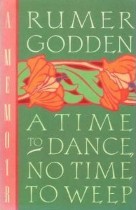 Rumer Godden •
Rumer Godden •
A Time to Dance, No Time to Weep •
Rumer Godden must have been a joy to know. Her sentences tumble headlong over each other in her rush to tell a story; sensory images spill from her in torrents, like the Kashmiri stream her two small daughters unstop after an army corps dams it up. “You needn’t worry,” the nine-year-old tells an astonished officer, “we left part of the stream for you.”
Much of Godden’s early life is spent in India, where she teaches dancing and begins writing her lyrical books. Her husband loses everything they own speculating in the stock market, then goes off to war. Godden is left with crippling debts, three enamel bowls and a Persian carpet—all that remains of their possessions—and two young children to raise by herself.
Undaunted, she spies a house high on a mountainside and decides that they will live there native style, without even knowing whether it is already inhabited (it isn’t) or if they can rent it (they can, for five rupees a month). “No glass in the windows, only brown paper, no electricity, no means of heating, no water except the stream.” It quickly becomes her favorite spot on earth. Godden has a genius for evoking place, and the peace and beauty of Dove House glow in her narrative.
At the book’s end, she is forced to flee from her beloved Kashmir through an absurd miscarriage of justice: The cook who attempted to poison her household by putting ground glass in their food goes free, but Godden is banished.
She gets on a boat for England, and writes.
Click here to read a review of Godden’s novel The Greengage Summer.







This sounds great, I’m going to have to read it! Also, gorgeous web site!!
Thank you!
hadn’t heard of this author— this sounds very good!
I’m currently besotted with this author; just watched Jean Renoir’s The River, based on the novel she wrote during that sea voyage. How can it be that somebody so good is virtually unknown today?
Godden’s adult novels are fantastic, but have you tried her YA/children’s stuff? I grew up reading them over and over. “The Diddakoi” is amazing, and I am still convinced that the Billy Elliot people just stole the plot of one of my favorite books of all time, “Thursday’s Children,” wholesale and didn’t bother attributing it (it’s crazy, actually, how similar major plot points are). For younger readers, “Miss Happiness and Miss Flower” and “Little Plum” are lovely, and deal really well with feelings of displacement, jealousy and loneliness. “The Doll’s House” and “The Rocking Horse Secret” are good for even younger readers, and then in picture books I still love “Holly and Ivy.”
I think the only book of hers that I didn’t end up reading over and over is “The Greengage Summer,” but I think I was just a bit young for some of the content when I read it in 5th or 6th grade. I’ll have to try it again.